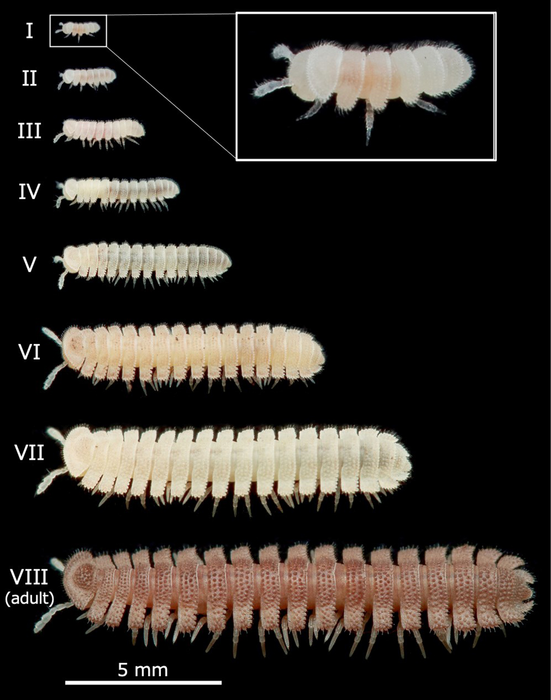Millipede legs grow in an unexpected way, according to new research. Previously, it was thought that when a millipede molts (sheds its exoskeleton), it grows new segments on the end of its body without legs. Then after the next molt, the previously new segments re-emerge with fully formed legs attached. However, a team at the University of Tokyo has found that new segments actually contain tiny bundles of legs, which appear as transparent protrusions before molting and then become fully formed afterwards. This discovery could help us understand how not only millipedes, but also other arthropods (invertebrates with jointed legs) grow.

Credit: 2023 Soma Chiyoda
Millipede legs grow in an unexpected way, according to new research. Previously, it was thought that when a millipede molts (sheds its exoskeleton), it grows new segments on the end of its body without legs. Then after the next molt, the previously new segments re-emerge with fully formed legs attached. However, a team at the University of Tokyo has found that new segments actually contain tiny bundles of legs, which appear as transparent protrusions before molting and then become fully formed afterwards. This discovery could help us understand how not only millipedes, but also other arthropods (invertebrates with jointed legs) grow.
If you’ve recently been for a picnic in the park, you’ll probably have had to contend with a few creepy-crawlies. One that you might come across trundling under a shady tree is the harmless millipede. Famous for its multitude of legs (though the first to have more than 1,000 was actually only discovered in 2021), it is thought to have been one of the first creatures to walk on land and breathe air about 420 million years ago. Their lifestyle of burrowing in the dirt and digesting decomposing plant matter means that they play a very important role in our ecosystems, but there is still a lot we don’t know about them, including exactly how they get all those famous legs.
“In 1855, French entomologist Jean-Henri Fabre proposed the ‘law of anamorphosis.’ That law indicated a pattern in millipede growth, in which legless segments are first added to the body by molting and then legs are added onto that segment in the next molt. However, the physical changes that occur when segments and legs are added were not clear,” explained Professor Toru Miura from the Graduate School of Science at the University of Tokyo. “Our study is significant in that it adds new morphological knowledge to the law of anamorphosis after 168 years.”
Researchers used a scanning electron microscope (SEM) to study a common species of millipede called Niponia nodulosa, during different stages of molting and growth. This technique enabled them to the view microscopic surface details on the bodies of the millipedes and look for any changes. The team also used another microscope called a confocal laser scanning microscope (CLSM) to look at what was happening inside the millipedes. “We expected that segments and legs would be added by molting, as happens in many other arthropods. However, we were surprised to find that drastic morphogenesis, the biological process of changing shape, actually started before molting,” said Miura.
When scanning the millipedes just a few days before molting, the team could already see two pairs of small, wrinkled legs under the cuticle of the legless segment. Just before the millipede molted, transparent protrusions containing the new bundle of legs were observed on the outer surface of the segment, covered by a thin tissue membrane. “Arthropods generally undergo morphological changes through molting, but the phenomenon discovered in this study deviates from this. With these millipedes at least, transparent protrusions with legs appeared from the elastic cuticle (an external layer that provides muscular support) before they molted,” said Miura. “This result suggests that changing shape without molting via the cuticle may also be important in other arthropods.”
As arthropods make up about 75% of all animal life on Earth, it was significant to the researchers that a familiar animal like the millipede could provide a new and important insight into its development and diversity. “Since it is not yet known whether this phenomenon is widely seen in other millipedes, we will need to study other species for comparison. We would also like to continue our research into the molecular mechanisms involved in anamorphosis, as these are still largely unclear,” said Miura. “Our work has shown us that there are still many surprising discoveries to be made in nature, right under our feet.”
###
Paper Title:
Soma Chiyoda, Kohei Oguchi, Toru Miura. Appearance of a transparent protrusion containing two pairs of legs on the apodous ring preceding the anamorphic molt in a millipede, Niponia nodulosa. Frontiers in Zoology 20: 14 (2023). DOI: 10.1186/s12983-023-00493-0.
Funding:
This research was supported by a Grant-in-Aid for Scientific Research A (No. 18H04006) from the Ministry of Education, Culture, Sports, Science.
Useful links
Graduate School of Science: https://www.s.u-tokyo.ac.jp/en/
Misaki Marine Biological Station: https://www.mmbs.s.u-tokyo.ac.jp/en/index.html
Miura Lab: https://sites.google.com/view/miura-lab/english-home
Research Contact:
Professor Toru Miura
Misaki Marine Biological Station
Graduate School of Science, The University of Tokyo
Misaki, Miura, Kanagawa 238-0225, Japan
Email: [email protected]
Tel.: 046-881-4105
Press contact:
Mrs. Nicola Burghall
Public Relations Group, The University of Tokyo,
7-3-1 Hongo, Bunkyo-ku, Tokyo 113-8654, Japan
[email protected]
About the University of Tokyo
The University of Tokyo is Japan’s leading university and one of the world’s top research universities. The vast research output of some 6,000 researchers is published in the world’s top journals across the arts and sciences. Our vibrant student body of around 15,000 undergraduate and 15,000 graduate students includes over 4,000 international students. Find out more at www.u-tokyo.ac.jp/en/ or follow us on Twitter at @UTokyo_News_en.
Journal
Frontiers in Zoology
DOI
10.1186/s12983-023-00493-0
Method of Research
Observational study
Subject of Research
Animals
Article Title
Appearance of a transparent protrusion containing two pairs of legs on the apodous ring preceding the anamorphic molt in a millipede, Niponia nodulosa.
Article Publication Date
18-Apr-2023




